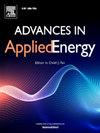Net Zero without the gridlock through peer-to-peer coordinated flexibility
IF 13.8
Q1 ENERGY & FUELS
引用次数: 0
Abstract
In the pursuit of Net Zero, the rapid adoption of electric vehicles, heat pumps, and distributed generation is placing unprecedented pressure on low-voltage electrical distribution networks. Can these networks adapt and evolve without facing gridlock? Our study proposes an innovative peer-to-peer coordinated flexibility strategy that has the potential to significantly transform the landscape. By aggregating individual flexibility through peer-to-peer coordination, this approach enhances local power balance, mitigates gridlock, and safeguards individual benefits. Through a novel large-scale network analysis method based on statistically similar networks, we have quantified the maximal potential of peer-to-peer coordinated flexibility in alleviating gridlock and deferring network expansion. Using real-world UK low-voltage electrical distribution network data and authoritative distributed energy resources roadmaps, our findings reveal that peer-to-peer coordinated flexibility can reduce peak power flows by up to 20 % and enable as much as 91 % of UK residential low-voltage electrical distribution networks to meet peak demand without gridlock by 2050, significantly reducing the need for network expansion. Furthermore, with the adoption of peer-to-peer coordinated flexibility, the network's peak is projected to occur between 2045–2050, postponing it by 8–10 years compared to scenarios without it. These results underscore the critical role of peer-to-peer coordinated flexibility and serve as a benchmark for the co-development of future grids and flexible resources when addressing associated implementation challenges such as technological infrastructure and consumer engagement.
通过点对点协调灵活性实现零网络
在追求净零排放的过程中,电动汽车、热泵和分布式发电的迅速普及给低压配电网络带来了前所未有的压力。这些网络能够适应和发展而不面临僵局吗?我们的研究提出了一种创新的点对点协调灵活性策略,它有可能显著改变景观。这种方法通过点对点协调聚合个人灵活性,增强了地方权力平衡,缓解了僵局,保障了个人利益。通过一种基于统计相似网络的新型大规模网络分析方法,我们量化了对等协调灵活性在缓解交通拥堵和延缓网络扩张方面的最大潜力。使用真实的英国低压配电网络数据和权威的分布式能源路线图,我们的研究结果显示,点对点协调的灵活性可以减少峰值功率流高达20%,并使多达91%的英国住宅低压配电网络在2050年之前满足峰值需求而不会出现僵局,大大减少了对网络扩展的需求。此外,随着点对点协调灵活性的采用,预计网络峰值将在2045-2050年之间出现,与没有它的情况相比,它将推迟8-10年。这些结果强调了点对点协调灵活性的关键作用,并在解决技术基础设施和消费者参与等相关实施挑战时,作为未来电网和灵活资源共同开发的基准。
本文章由计算机程序翻译,如有差异,请以英文原文为准。
求助全文
约1分钟内获得全文
求助全文

 求助内容:
求助内容: 应助结果提醒方式:
应助结果提醒方式:


